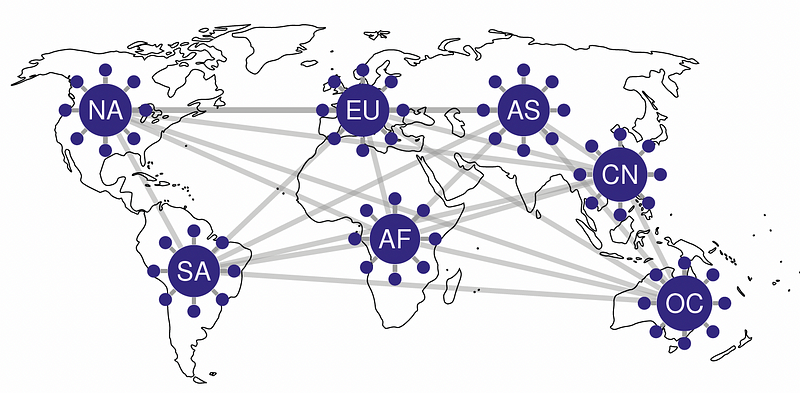Analysing The Bitcoin Network: Did you know that the EU has the largest number of miners and peers?

Analysing The Bitcoin Network: Did you know that the EU has the largest number of miners and peers?
Whether you like Bitcoin or not, it should be acknowledged that it is an amazing machine, that had kept going for over a decade, and is completed distributed.
Read a paper
My simple advice to researchers. Continually read papers. Sit down for an hour or two and read a full paper. If you can experiment with the method and try and implement it. And so my favouriate paper this week is [here]:

I love this paper as it gives a basic evaluation of real-life blockchain operations.
Analysing the Bitcoin network
While it focuses on the Bitcoin network, the core measurements could be applied to any public blockchain infrastructure. For this the researchers measured the data rates for various AWS regions for us-west-1 (NA), sa-east-1 (SA), eu-central-1 (EU), ap-southeast-2 (OC), ap-south-1 (AS), me-south-1 (AF), and ap-east-1 (CN):

The assessment connects to one Bitcoin peer at a time and then requests as many blocks as possible for a fixed time frame. The bandwidth is then computed from the number of blocks over the time period:

We can see that NA (North America), SA (South America), EU (Europe), and AS (Asia Pacific South) are well connected, but AF (Middle East South) and OC (Asia Pacific East) have weaker performance, with CN (Asia Pacific East) having the poorest overall performance. This is likely to be related to the “Great Firewall” of China being a bottleneck. While bandwidth is important the latency of the connections are also a key metric. For this, most of the regions had a median latency of less than 300ms, but the EU and NA were the fastest to respond with a mean RTT (Round Trip Time) of 176 ms, with AF (Middle East South) being the slowest:

One surprising thing here is that CN does not perform that badly for latency, but the researchers outline that this is probably due to ICMP packets not being affected by the “Great Firewall” of China. In terms of where the peers and miners were, we can see the majority of the peers are in the EU and NA, and that the EU has the majority of the mining share:

An observation here from the researchers is that CN provides three times more mining than peers, which shows the region is more involved in mining than in creating blocks. The researchers outline that there has been a massive change as a previous study showed that the CN region provided 77.6% of mined blocks, while only accounting for 3.9% of the peers.
When it came to block sizes and delays, there was a perceivable increase in delay times when dealing with larger block sizes:

An important element of Bitcoin is the propagation of blocks. The following it was found that miners in the EU, NA, and AS regions are able to propagate their blocks the quickest, while miners in the AF, SA, and CN regions took more than 84% longer than EU miners to propagate their blocks. The slowest were miners in the OC region which took over twice as long to propagate their blocks than miners in the EU region:

Conclusions
The researchers use their experiments to build a model of the Bitcoin network using the bns framework. They think it is much better in its construction than existing simulators such BlockSim, as it takes into account real-life variations on a geographical level.
References
[1] Rohrer, E., & Tschorsch, F. Blockchain Layer Zero: Characterizing the Bitcoin Network through Measurements, Models, and Simulations.